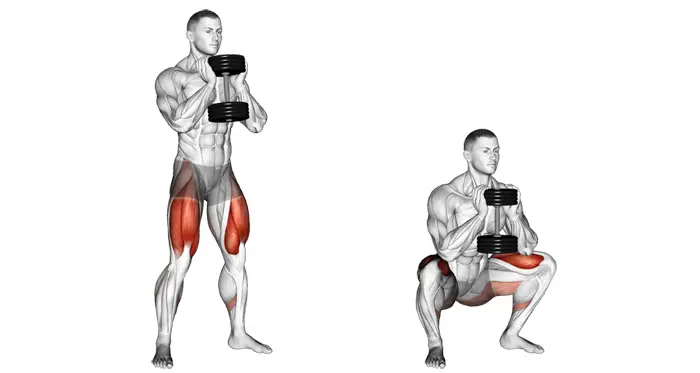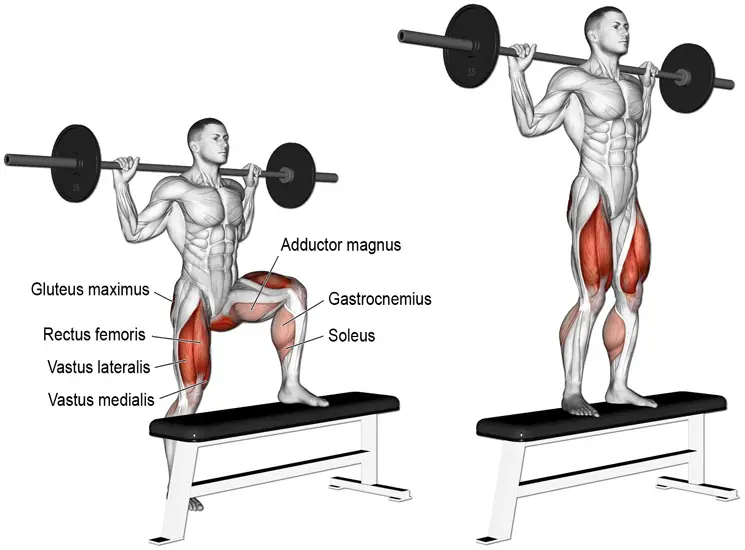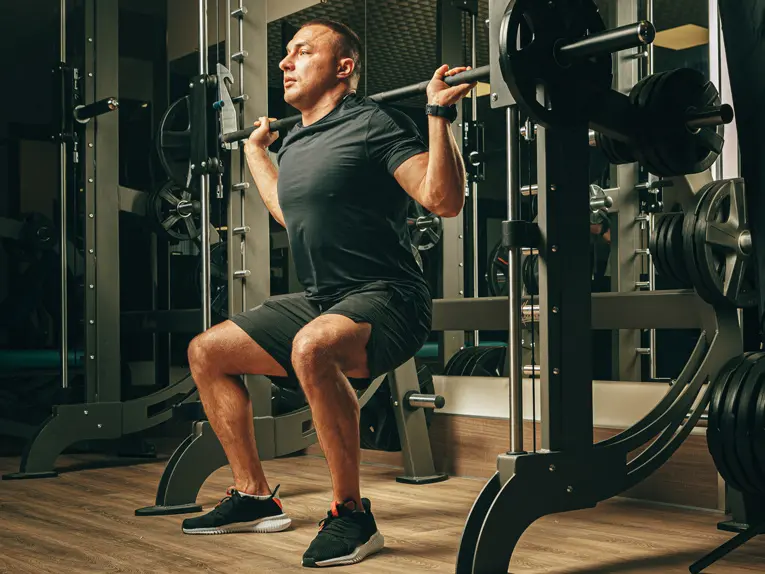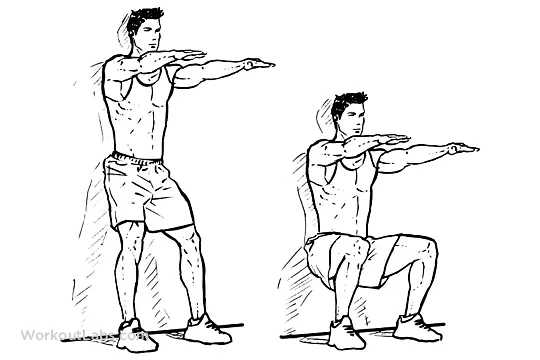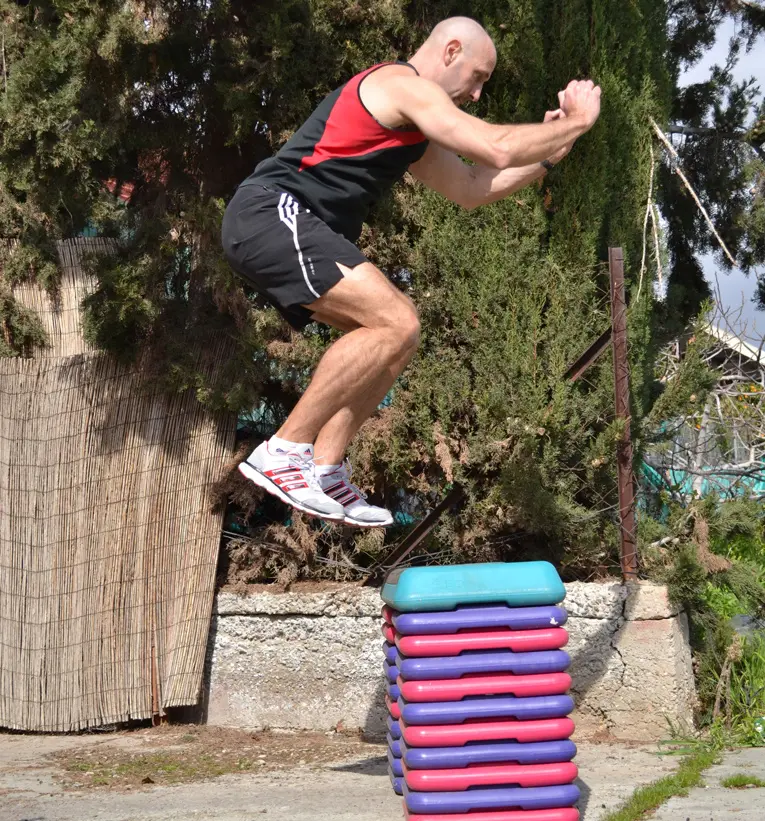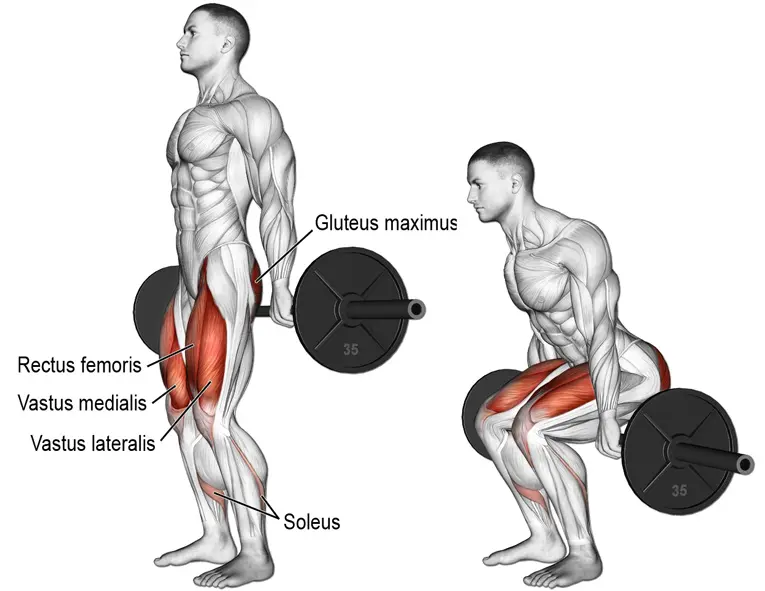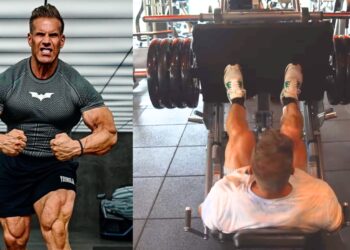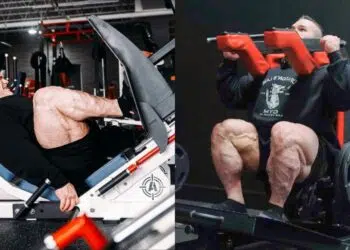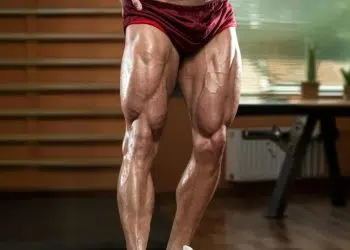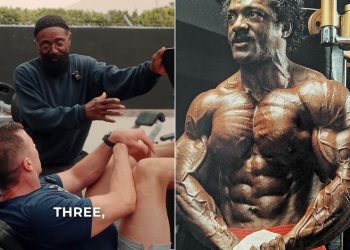The leg press machine is a hugely popular exercise. Like the king of exercisers uses, squats, it can help you build muscle size, strength, and even muscle power and speed (1). It’s a staple of most bodybuilders’ leg workouts, and it allows you to lift heavy weights with very little stress on your lower back.
But, like any exercise, it’s possible to have too much of a good thing. If all you do is leg press, your muscles will eventually adapt, and your progress will grind to a halt. In time, no matter how hard you work, your muscles won’t get bigger or stronger if all you do is the leg press.
Use these ten alternatives to breathe new life into your lower body workouts.
Leg press 101
Before we dive into the best leg press machine alternatives, let’s spend a few minutes talking about what makes this exercise so effective. After all, there is a reason why it’s so popular!
Easy to learn – a lot of leg exercises take time to master. Squats and lunges, for example, can be tricky exercises to learn. Leg presses are much more instant. Yes, they can still be done incorrectly, but there is a lot less to go wrong than with most free weight leg exercises.
Increased safety – unless you’ve got access to a squat rack, or a crew of strong and competent spotters, squatting with heavy weights or going to failure can be very dangerous. Just ask powerlifter Alexander Sedykh who broke both his knees in a failed attempt to squat 400kg/880 lbs. Leg press machines have safety catches you can engage to support the weight and stop it descending too far. This means you can lift heavy weights and train to failure in safety.
Level Up Your Fitness: Join our 💪 strong community in Fitness Volt Newsletter. Get daily inspiration, expert-backed workouts, nutrition tips, the latest in strength sports, and the support you need to reach your goals. Subscribe for free!
Back support – with free weight exercises such as squats and deadlifts, you need to use your core muscles to support your spine. Even if you use a weightlifting belt, you’ll still need to use your core to create the intra-abdominal pressure necessary to maintain a neutral spine. Needless to say, the heavier the weight, the more stress there is on your lower back during these exercises.
When leg pressing, your back is supported by the seat, taking most of the stress off your lower back. Because you don’t have to worry so much about your back, you’re free to focus on pushing your legs to the limit!
That doesn’t mean you can’t hurt your back during leg presses. If you lower the weight too far and allow your lower back to round, or use an excessive amount of weight, you can still injure yourself. However, done correctly, the leg press has the potential to be safer for your lower back than some free weight exercises.
Hit different muscles by moving your feet – leg presses work all of your lower body muscles, including your glutes, hamstrings, quadriceps, adductors, and abductors. However, by moving your feet, you can emphasize different parts of your legs to sculpt the lower body you want (2).
Placing your feet higher on the footplate will increase hamstring and glute activation while placing your feet lower will emphasize your quads. Adopting a wide stance will increase adductor or inner thigh recruitment.
It should be noted that while you can work different muscles by moving your feet, it’s not a good idea to use extreme positions as doing so could place too much stress on your joints. For example, a very low foot position is hard on your knees.
Better for training systems – training systems are methods that you can use to increase the intensity of your workouts. Examples include drop sets, 21s, and paused reps. While you can use training systems with free weight exercises, they’re often easier to employ with machines. Take your next leg work out to a whole new level by doing leg press drop sets or 21s.
Disengage your brain – leg press machines guide the weight, so you don’t need to worry too much about balancing the load. In addition, the movement itself is very simple. Because of this, you can disengage your brain and just focus 100% on lifting and lowering the weight. This can be a big relief if you’ve had a hard day at work or are feeling distracted. In contrast, even a small lapse in concentration during something like squats could be disastrous.
Because of this, leg presses are also an excellent way to end your lower body workout because, even if you are mentally and physically tired, you can still push yourself hard in safety.
With all of that said and done, and as good as the leg press is, there will be times when you won’t have access to this machine or need to take a break from it. Here are ten alternatives to leg presses.
10 Best Leg Press Alternatives
These exercises work the same muscles as the leg press and offer many of the benefits of this popular machine. Use them to give yourself a break from leg pressing, or anytime you don’t have access to a leg press machine, such as when training at home.
1. Inverted Smith Machine Leg press
This exercise is how old-school exercisers used to do leg presses before modern leg press machines were invented. It takes a little getting used to but, once you’ve practiced it a few times, this is a very useful lower body exercise that is especially good for your hamstrings and glutes.
How to do it:
- Set the bar on a Smith machine to about hip-height. Engage the safety catches to stop the bar descending beyond this point.
- Lie on your back below the bar and place your feet against the underside and about shoulder-width apart.
- Extend your legs and push the bar up, and then lower it back to the safety catches.
- Lower the safety catches according to your leg length and flexibility. You should bend your legs are far as possible while keeping your lower back flat on the floor.
- This exercise can also be done one leg at a time.
Training at home? You can replicate this exercise by looping a resistant band over your feet.
2. Goblet squats
Goblet squats are easier to learn and safer to perform than back squats. They use the same movement pattern as leg presses. With the weight in front of your chest, they all but force you to maintain an upright torso, minimizing stress on your lower back. This makes them a very viable alternative to leg presses.
How to do it:
- Hold a dumbbell or kettlebell in front of your chest and just beneath your chin. Step out and into a shoulder-width stance, with your toes turned slightly outward. Brace your abs.
- Bend your legs and squat down until your thighs are roughly parallel to the floor. Keep your lower back slightly arched; no rounding!
- Stand back up and repeat.
- Use a wider stance to increase adductor recruitment or a narrower stance to hit your quads more.
3. Weighted step-ups
Level Up Your Fitness: Join our 💪 strong community in Fitness Volt Newsletter. Get daily inspiration, expert-backed workouts, nutrition tips, the latest in strength sports, and the support you need to reach your goals. Subscribe for free!
Step-ups might not look a lot like leg-presses, but the leg action is very similar, albeit one leg at a time. In addition, your torso remains very upright, which keeps the stress off your lower back, just like leg presses do. This is a good at-home leg press alternative.
How to do it:
- With dumbbells in your hands or a barbell across your upper back, stand facing a stable knee-high step or box. The higher the step, the harder this exercise will be.
- Place one foot flat on the top of the step, drive that foot downward, and stand up on top of the box. Try not to push off the floor with the other leg – your leading leg should do most of the work.
- Step down and either step up with the same leg or, if you prefer, alternate legs.
- No weights? No problem? You can also do this exercise without weights or while wearing a backpack for added resistance.
4. Smith machine squats
Smith machine squats are much easier to learn and perform than regular free weight barbell squats. The weight is guided on rods, so you don’t have to worry too much about balancing the bar. Instead, like leg presses, you are free to focus on lowering and lifting the weight. You still need to maintain a neutral spine, but this is easier than with barbell squats.
How to do it:
- Duck under the bar so that it rests across your upper traps and not on your neck. Stand up and step out into a shoulder-width stance. Move your feet forward a few inches. Grip the bar tightly and brace your abs.
- Bend your knees and squat down until your thighs are roughly parallel to the floor. Do not round your lower back.
- Stand back up and repeat.
- Use a wider stance to increase adductor recruitment or a narrower stance to hit your quads more.
5. Wall squats
Wall squats are an isometric exercise. That means they involve lots of muscle tension, but no actual movement. They’re a useful home training exercise as you don’t need any equipment to do them.
How to do it:
- Stand with your back against a smooth, sturdy wall. Move your feet forward about 18-24 inches.
- Bend your legs and slide your back down the wall until your thighs are parallel to the floor.
- Push your back against the wall as hard as you can and for as long as you can. Keep your hands away from your legs – do not use them for help.
- Make this exercise even harder by holding dumbbells in your hands.
6. Bulgarian split squats
This is another exercise that looks nothing like the leg press but is actually a very good alternative, both for the gym and home use. Like the leg press, this move places very little stress on your lower back. It works one leg at a time, which means it’s an excellent way to spot and fix left-to-right strength imbalances.
How to do it:
- Stand with your back to a knee-high bench, step, or chair. Bend one leg and place your foot on the bench behind you. Hop forward and into a split stance.
- Bend your legs and lower your rear knee down toward the floor. Keep your torso upright.
- Stand back up and repeat. Do the same number of reps on each leg.
- Make this exercise harder by holding dumbbells in your hands or a barbell across your upper back. You can also do this exercise using a Smith machine.
7. Box jumps
Box jumps are an excellent exercise for developing muscle power. Muscle power is your ability to generate force quickly and is an essential part of most sports. It uses the same muscles as leg pressing, but you’re going to move a whole lot faster.
How to do it:
- Stand facing a sturdy bench or box. The box should be about knee-height. You can use a higher box once you have mastered this exercise. Your feet should be about shoulder-width apart.
- Bend your legs and swing your arms behind you.
- Jump forward and upward, using your arms for extra momentum, and land on the benchtop with your knees slightly bent.
- Step down, reset your feet, and repeat.
- As well as raising the height of the box, you can also make this exercise harder by holding dumbbells or wearing a weighted vest.
8. Step-through lunges
All types of lunges can be used as alternatives to leg presses. This exercise combines forward and backward lunges, working both legs at the same time. It’s a good home exercise that you can also do at the gym. Use a barbell or dumbbells for resistance, or just your bodyweight if you prefer.
How to do it:
- Stand with your feet together, torso upright, and looking straight ahead.
- Step backward, bend your legs, and lower your rearmost knee down toward the floor.
- Next, step forward and bend your legs again, lowering your other knee down to the floor.
- Alternate between backward and forward lunges for the duration of your set.
- Rest a moment and then do the same number of reps on the opposite side.
9. Barbell hip thrusts
Leg presses work all your lower body muscles, but placing your feet higher on the footplate means they use your glutes and hamstrings more than your quads. This leg press alternative is all about those glutes and hammies, making it a good option when you want to preferentially target these muscles.
How to do it:
- Sit on the floor and place your upper back against a sturdy bench. Rest and hold a barbell across your hips. Protect your hips by using a folded towel or barbell pad.
- Bend your legs and place your feet flat on the floor.
- Dive your feet into the floor and lift your hips up until your shoulders, hips, and knees form a straight line.
- Lower your butt back down the floor and repeat.
- Make this exercise harder by using just one leg at a time.
10. Barbell hack squats
The barbell hack squat is a traditional leg exercise that bodybuilders used to do long before the leg press was invented. Don’t think that means it’s outdated; the barbell hack squat is still a challenging, effective exercise and a viable leg press alternative.
How to do it:
- Hold a barbell behind your back with your palms facing behind you. Stand with your feet about shoulder-width apart. Brace your abs.
- Bend your knees and squat down, sliding the bar down the backs of your legs. Do not round your lower back.
- Stand back up and repeat.
- You may find this exercise a little easier if you raise your heels by putting them on small weight plates or a plank of wood.
Leg Press Alternatives – Wrapping Up
We all love the leg press, and it’s easy to see why. It allows you to lift heavy weights in relative safety and rep out to failure without worrying too much about dropping the weight. And leg press drop sets are one of the most intense leg training methods you can use!
But, as much as we love the leg press, you can have too much of a good thing. If you always leg press, your body will eventually become accustomed to it, and your progress will grind to a halt. There is nothing more frustrating than a training plateau.
Replace the leg press with any of these ten alternatives. Each one works the same muscles but is different enough that it will add some much-needed variety to your workouts, making them productive again.
Whether you work out in a gym or train at home, these ten leg press machine alternatives will ensure that your workouts produce the results you want.
References:
- Journal of Strength and Conditioning Research: The Impact of Back Squat and Leg-Press Exercises on Maximal Strength and Speed-Strength Parameters (source)
- PubMed: Analysis of muscle activation during different leg press exercises at submaximum effort levels (source)
Interested in measuring your progress? Check out our strength standards for Smith Machine Squat, Bulgarian Split Squat, Goblet Squat, and more.



